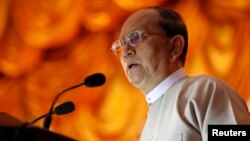WASHINGTON —
Burma, also known as Myanmar is set to grow 7.5 percent during the current fiscal year, and about 7.7 percent in the next, the IMF said on Tuesday, as services and manufacturing expand in one of Southeast Asia's fastest-growing economies.
The International Monetary Fund last predicted Burma would grow just under 7 percent this year. But the Fund warned about the outlook for inflation, which should exceed 6 percent in the fiscal year that ends in March.
Burma, a former pariah state in Southeast Asia, has launched a series of economic and political reforms under its quasi-civilian government, which came to power in 2011 after nearly half a century of military rule. The government has aimed to attract foreign investment, create jobs and boost infrastructure.
The IMF, which had a staff-monitored program for Burma last year, said officials had achieved all the goals they set, such as liberalizing the foreign exchange market and building up the central bank's reserves.
It also said the government had met its fiscal deficit target of 5 percent of gross domestic product, though the current account deficit should widen.
"Risks to the outlook arise largely from limited macroeconomic management capacity and narrow cushions," the IMF's team leader for Burma, Matt Davies, said after a visit to the country.
"Inflation remains elevated and there are pressures from rapid money and credit growth, kyat depreciation and possible electricity price hikes. International reserves are still low and vulnerable to shocks."
The IMF welcomed Burma's decision to allow some foreign banks to operate in the country, but said they should be let in gradually as the government still has limited supervisory resources.
The International Monetary Fund last predicted Burma would grow just under 7 percent this year. But the Fund warned about the outlook for inflation, which should exceed 6 percent in the fiscal year that ends in March.
Burma, a former pariah state in Southeast Asia, has launched a series of economic and political reforms under its quasi-civilian government, which came to power in 2011 after nearly half a century of military rule. The government has aimed to attract foreign investment, create jobs and boost infrastructure.
The IMF, which had a staff-monitored program for Burma last year, said officials had achieved all the goals they set, such as liberalizing the foreign exchange market and building up the central bank's reserves.
It also said the government had met its fiscal deficit target of 5 percent of gross domestic product, though the current account deficit should widen.
"Risks to the outlook arise largely from limited macroeconomic management capacity and narrow cushions," the IMF's team leader for Burma, Matt Davies, said after a visit to the country.
"Inflation remains elevated and there are pressures from rapid money and credit growth, kyat depreciation and possible electricity price hikes. International reserves are still low and vulnerable to shocks."
The IMF welcomed Burma's decision to allow some foreign banks to operate in the country, but said they should be let in gradually as the government still has limited supervisory resources.







